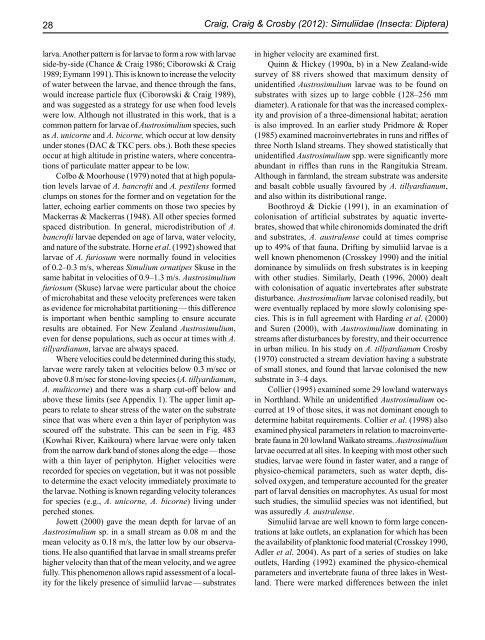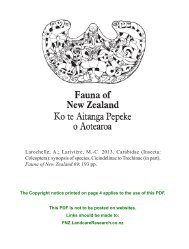Fauna of New Zealand 68 - Landcare Research
Fauna of New Zealand 68 - Landcare Research
Fauna of New Zealand 68 - Landcare Research
Create successful ePaper yourself
Turn your PDF publications into a flip-book with our unique Google optimized e-Paper software.
28<br />
larva. Another pattern is for larvae to form a row with larvae<br />
side-by-side (Chance & Craig 1986; Ciborowski & Craig<br />
1989; Eymann 1991). This is known to increase the velocity<br />
<strong>of</strong> water between the larvae, and thence through the fans,<br />
would increase particle flux (Ciborowski & Craig 1989),<br />
and was suggested as a strategy for use when food levels<br />
were low. Although not illustrated in this work, that is a<br />
common pattern for larvae <strong>of</strong> Austrosimulium species, such<br />
as A. unicorne and A. bicorne, which occur at low density<br />
under stones (DAC & TKC pers. obs.). Both these species<br />
occur at high altitude in pristine waters, where concentrations<br />
<strong>of</strong> particulate matter appear to be low.<br />
Colbo & Moorhouse (1979) noted that at high population<br />
levels larvae <strong>of</strong> A. bancr<strong>of</strong>ti and A. pestilens formed<br />
clumps on stones for the former and on vegetation for the<br />
latter, echoing earlier comments on those two species by<br />
Mackerras & Mackerras (1948). All other species formed<br />
spaced distribution. In general, microdistribution <strong>of</strong> A.<br />
bancr<strong>of</strong>ti larvae depended on age <strong>of</strong> larva, water velocity,<br />
and nature <strong>of</strong> the substrate. Horne et al. (1992) showed that<br />
larvae <strong>of</strong> A. furiosum were normally found in velocities<br />
<strong>of</strong> 0.2–0.3 m/s, whereas Simulium ornatipes Skuse in the<br />
same habitat in velocities <strong>of</strong> 0.9–1.3 m/s. Austrosimulium<br />
furiosum (Skuse) larvae were particular about the choice<br />
<strong>of</strong> microhabitat and these velocity preferences were taken<br />
as evidence for microhabitat partitioning — this difference<br />
is important when benthic sampling to ensure accurate<br />
results are obtained. For <strong>New</strong> <strong>Zealand</strong> Austrosimulium,<br />
even for dense populations, such as occur at times with A.<br />
tillyardianum, larvae are always spaced.<br />
Where velocities could be determined during this study,<br />
larvae were rarely taken at velocities below 0.3 m/sec or<br />
above 0.8 m/sec for stone-loving species (A. tillyardianum,<br />
A. multicorne) and there was a sharp cut-<strong>of</strong>f below and<br />
above these limits (see Appendix 1). The upper limit appears<br />
to relate to shear stress <strong>of</strong> the water on the substrate<br />
since that was where even a thin layer <strong>of</strong> periphyton was<br />
scoured <strong>of</strong>f the substrate. This can be seen in Fig. 483<br />
(Kowhai River, Kaikoura) where larvae were only taken<br />
from the narrow dark band <strong>of</strong> stones along the edge — those<br />
with a thin layer <strong>of</strong> periphyton. Higher velocities were<br />
recorded for species on vegetation, but it was not possible<br />
to determine the exact velocity immediately proximate to<br />
the larvae. Nothing is known regarding velocity tolerances<br />
for species (e.g., A. unicorne, A. bicorne) living under<br />
perched stones.<br />
Jowett (2000) gave the mean depth for larvae <strong>of</strong> an<br />
Austrosimulium sp. in a small stream as 0.08 m and the<br />
mean velocity as 0.18 m/s, the latter low by our observations.<br />
He also quantified that larvae in small streams prefer<br />
higher velocity than that <strong>of</strong> the mean velocity, and we agree<br />
fully. This phenomenon allows rapid assessment <strong>of</strong> a locality<br />
for the likely presence <strong>of</strong> simuliid larvae — substrates<br />
Craig, Craig & Crosby (2012): Simuliidae (Insecta: Diptera)<br />
in higher velocity are examined first.<br />
Quinn & Hickey (1990a, b) in a <strong>New</strong> <strong>Zealand</strong>-wide<br />
survey <strong>of</strong> 88 rivers showed that maximum density <strong>of</strong><br />
unidentified Austrosimulium larvae was to be found on<br />
substrates with sizes up to large cobble (128–256 mm<br />
diameter). A rationale for that was the increased complexity<br />
and provision <strong>of</strong> a three-dimensional habitat; aeration<br />
is also improved. In an earlier study Pridmore & Roper<br />
(1985) examined macroinvertebrates in runs and riffles <strong>of</strong><br />
three North Island streams. They showed statistically that<br />
unidentified Austrosimulium spp. were significantly more<br />
abundant in riffles than runs in the Rangitukia Stream.<br />
Although in farmland, the stream substrate was andersite<br />
and basalt cobble usually favoured by A. tillyardianum,<br />
and also within its distributional range.<br />
Boothroyd & Dickie (1991), in an examination <strong>of</strong><br />
colonisation <strong>of</strong> artificial substrates by aquatic invertebrates,<br />
showed that while chironomids dominated the drift<br />
and substrates, A. australense could at times comprise<br />
up to 49% <strong>of</strong> that fauna. Drifting by simuliid larvae is a<br />
well known phenomenon (Crosskey 1990) and the initial<br />
dominance by simuliids on fresh substrates is in keeping<br />
with other studies. Similarly, Death (1996, 2000) dealt<br />
with colonisation <strong>of</strong> aquatic invertebrates after substrate<br />
disturbance. Austrosimulium larvae colonised readily, but<br />
were eventually replaced by more slowly colonising species.<br />
This is in full agreement with Harding et al. (2000)<br />
and Suren (2000), with Austrosimulium dominating in<br />
streams after disturbances by forestry, and their occurrence<br />
in urban milieu. In his study on A. tillyardianum Crosby<br />
(1970) constructed a stream deviation having a substrate<br />
<strong>of</strong> small stones, and found that larvae colonised the new<br />
substrate in 3–4 days.<br />
Collier (1995) examined some 29 lowland waterways<br />
in Northland. While an unidentified Austrosimulium occurred<br />
at 19 <strong>of</strong> those sites, it was not dominant enough to<br />
determine habitat requirements. Collier et al. (1998) also<br />
examined physical parameters in relation to macroinvertebrate<br />
fauna in 20 lowland Waikato streams. Austrosimulium<br />
larvae occurred at all sites. In keeping with most other such<br />
studies, larvae were found in faster water, and a range <strong>of</strong><br />
physico-chemical parameters, such as water depth, dissolved<br />
oxygen, and temperature accounted for the greater<br />
part <strong>of</strong> larval densities on macrophytes. As usual for most<br />
such studies, the simuliid species was not identified, but<br />
was assuredly A. australense.<br />
Simuliid larvae are well known to form large concentrations<br />
at lake outlets, an explanation for which has been<br />
the availability <strong>of</strong> planktonic food material (Crosskey 1990,<br />
Adler et al. 2004). As part <strong>of</strong> a series <strong>of</strong> studies on lake<br />
outlets, Harding (1992) examined the physico-chemical<br />
parameters and invertebrate fauna <strong>of</strong> three lakes in Westland.<br />
There were marked differences between the inlet
















